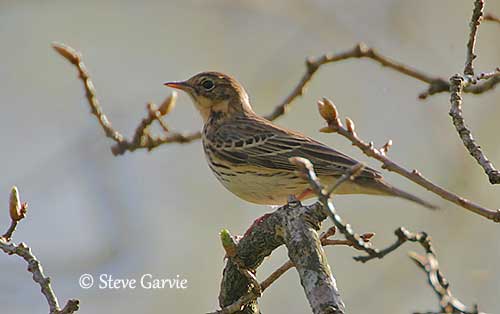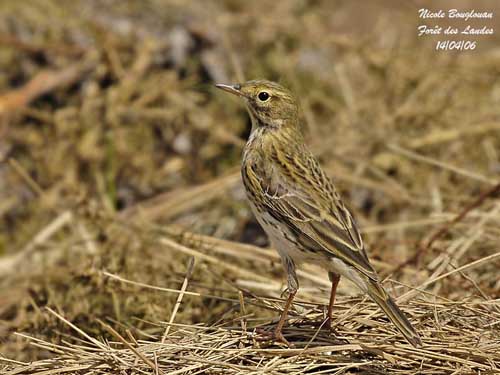
Fr: Pipit des arbres
Ang: Tree Pipit
All: Baumpieper
Esp: Bisbita Arbóreo
Ita: Prispolone
Nd: Boompieper
Sd: Trädpiplärka
Photographers:
John Anderson
John Anderson Photo Galleries
Steve Garvie
RAINBIRDER Photo galleries & Flickr Rainbirder
Otto Plantema
Trips around the world
Nicole Bouglouan
PHOTOGRAPHIC RAMBLE
Text by Nicole Bouglouan
Sources:
HANDBOOK OF THE BIRDS OF THE WORLD Vol 9 - by Josep del Hoyo - Andrew Elliot - David Christie - Lynx Edicions - ISBN: 8487334695
THE HANDBOOK OF BIRD IDENTIFICATION FOR EUROPE AND THE WESTERN PALEARCTIC by Mark Beaman, Steve Madge - C. Helm - ISBN: 0713639601
THE COMPLETE BOOK OF BRITISH BIRDS – Written by “Royal Society for the Protection of Birds” experts - Préface de Magnus Magnusson - Michael Cady- Rob Hume Editors - ISBN: 0749509112
ENCYCLOPEDIE DES OISEAUX DE FRANCE ET D’EUROPE – de Peter Hayman et Rob Hume - Flammarion – ISBN : 2082009920
Wikipedia, the free encyclopaedia
Birdwatch – The home of birding
MANCHESTER BIRDING- Birds, Birders and Birding in Greater Manchester
Manchester Birding - Trivialis tribulations by Ian McKerchar
SOUNDS - British wildlife recordings
Tree Pipit – Anthus trivialis
Passeriformes Order – Motacillidae Family
INTRODUCTION:
The Tree Pipit closely resembles Meadow Pipit in plumage, but it is often more streamlined, with a longer overall appearance. On the ground, the Tree Pipit moves with a more horizontal gait, whereas the Meadow Pipit has more upright stance.
Some differences in bill shape and bill colour are conspicuous at close range. The Tree Pipit has heavier and more wedge-shaped bill, mostly pale pink like legs and feet too, whereas the Meadow Pipit has mostly brownish-orange bill, legs and feet.
Another feature difficult to see in the wild: the hind claws. The Tree Pipit is an arboreal species, and it has much shorter and more steeply curved hind claw than the Meadow Pipit which is mostly terrestrial, with 10-13 mm in Meadow Pipit, and 7-9 mm in Tree Pipit (Svensson – 1992).
As its name suggests, the Tree Pipit makes more use of trees than other pipits, and especially at the beginning of the breeding season during the aerial displays. However, it feeds and nests on the ground, but flies up quickly into tree or bush when disturbed or alarmed.
This European Breeder is migratory and winters in sub-Saharan Africa and in India. It is common throughout the wide range.

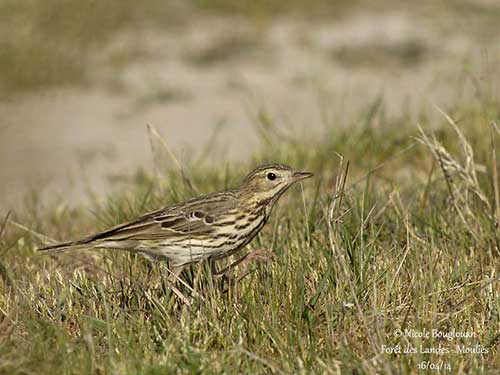
With upright stance
Tree Pipit
With horizontal gait
DESCRIPTION OF THE BIRD:
Biometrics:
Length: 14-16 cm
Wingspan: 25-27 cm
Weight: 15-39 g
On the upperparts, the Tree Pipit has the mantle less conspicuously streaked in fresh plumage, whereas in worn plumage (mid-summer), it is much duller and lacks the warm tones of the spring plumage. As the streaking on mantle becomes more prominent, the bird becomes more similar to the Meadow Pipit.
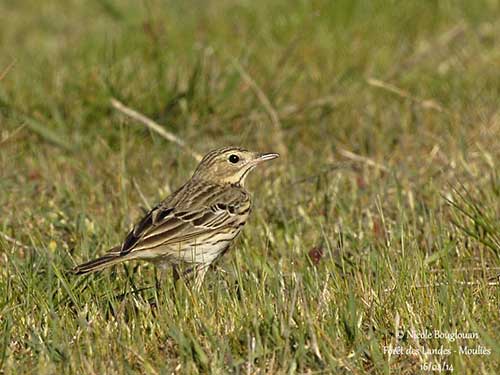
On the underparts, the throat is warmer buff, while breast and flanks contrast with the whiter belly. On the breast, the streaks form broad, evenly spaced stripes, whereas the flanks show only weak, insignificant streaking.
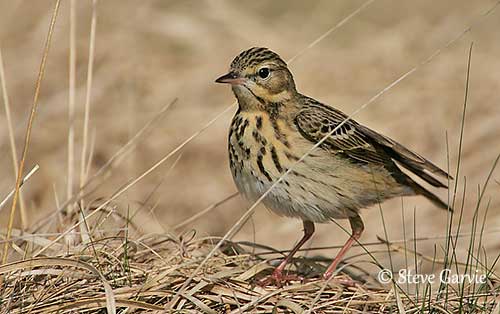
On the head, the Tree Pipit has streaked crown. It has a weak buffish supercilium and a small, pale spot on rear of ear-coverts. There is a narrow, dark loral line cutting the whitish eyering, and a more distinct, pale submoustachial stripe and blackish-brown malar stripe.
The wedge-shaped bill is pale pink along the base of the lower mandible, and dark grey to blackish on upper mandible and tip. The eyes are dark brown with whitish eyering. Legs and feet are pale pink with shorter, more curved hind-claw.
Male and female are similar.
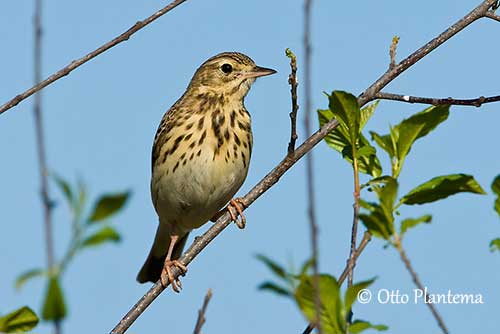
The juvenile resembles adult in fresh plumage, but on the upperparts, the feather centres are blacker and more rounded, with conspicuous pale buff fringes giving a scaly appearance. It is more buff-brown than adults.
SUBSPECIES AND RANGE:
The Tree Pipit has two recognized subspecies.
A.t. trivialis (described above and displayed) breeds from N and W Europe (except Iceland and Ireland), E to L Baikal and middle R Aldan, and in S, from N Mediterranean and N Turkey E to Trans-Caucasus and N Iran. It winters in sub-Saharan Africa and in India.
A.t. haringtoni breeds in NW Himalayas (Kashmir E to Garhwal). It winters in Indian Subcontinent.
This race differs from nominate in more earth-brown (less olive) upperparts, paler fulvous breast and flanks, and heavier streaking on breast.
HABITAT:
The Tree Pipit breeds in a variety of wooded habitat including edges, open and cleared woodlands, young conifer plantations with scattered remaining tall trees. It also breeds from heathland to forest clearings, and in treeline area in mountains (race haringtoni).
During the migration, it frequents similar habitats and more open areas too.
Outside breeding season, it can be seen in almost any habitat with trees and dense bushy cover, in open savanna, in cultivated fields and coffee plantations with tall trees. It may occur up to 3000 metres of elevation in Africa.
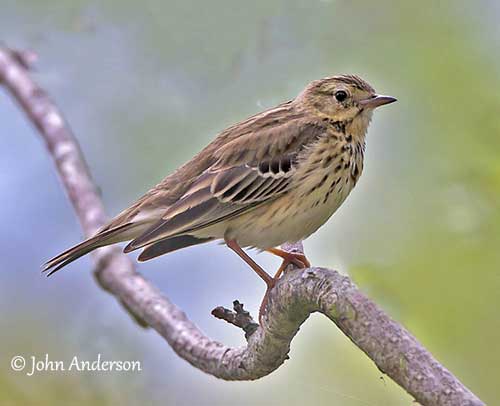
CALLS AND SONGS: SOUNDS BY XENO-CANTO
The Tree Pipit’s flight call is a hoarse, thin “teeez” or “beeez” often given singly. The alarm call during the breeding season is a weak “tsyip” or “syt”.
The song is given from treetop or in flight. It is a series of musical trills and repeated, drawn-out notes “swee-ur, swee-ur, swee-ur” while the bird descends in parachute flight.
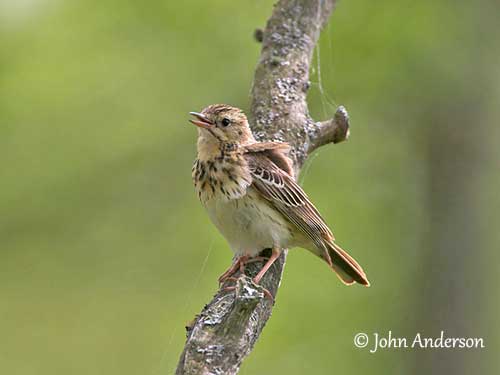
BEHAVIOUR IN THE WILD:
The Tree Pipit feeds on the ground and sometimes on branches and tree trunks or stumps. It usually feeds within the vegetal cover, and flies up into bushes and trees when disturbed. During the migration, it often feeds in open areas with limited cover. They form small to medium-sized flocks during winter.
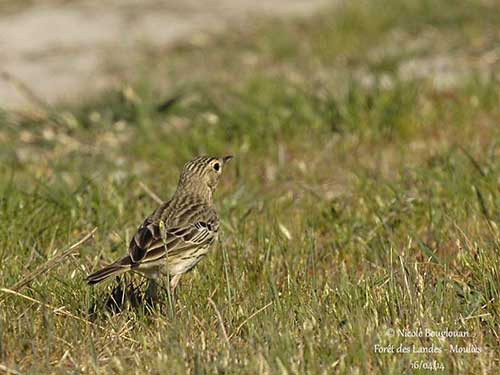
The diet includes a variety of invertebrates, and mostly insects such as Coleopteran, Hemipteran, leaf beetles (Chrysomelidae), caterpillars, grasshoppers (Orthoptera), and spiders and snails.
During winter, it feeds on some plant material such as fruits of bilberry, buds of aspen and seeds of pines and birches. It also takes nectar of Erythrina (Fabaceae) in Africa.
The Tree Pipit is arboreal and often walks along branches while pumping its tail, like numerous Motacillidae.
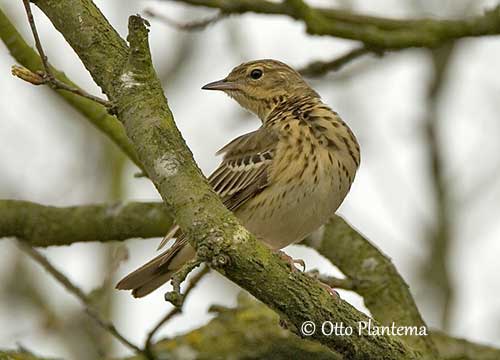
During the breeding season, the Tree Pipit male arrives first and takes up a territory. It performs spectacular song flight. It flies upwards from a high perch at treetop and begins to sing as it reaches the top of its ascent. Then, it descends with wings open and tail spread in parachute flight, while it dangles its legs. It alights often on the same perch. Other displays show the male chasing the female in fast, jerky flight.
They are monogamous, and occasionally, but rarely polygamous.
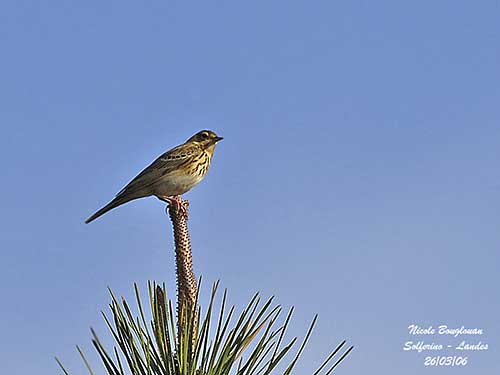
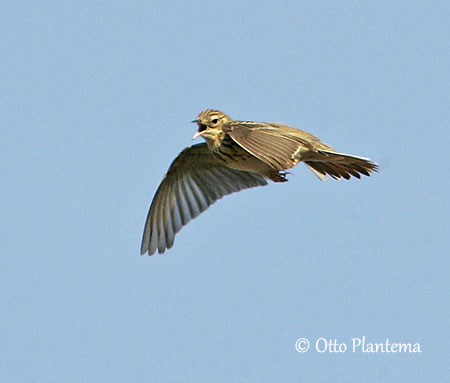
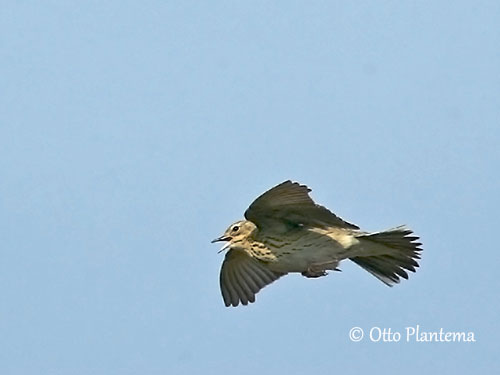
A Common Chiffchaff can be heard in the background
The Tree Pipit is migratory and long-distance migrant. They leave their breeding grounds in August/September and reach the S parts of Africa in late October/early November. They leave the wintering areas in February/March, and arrive in C Europe in early April, reaching the northern parts of the breeding range in May.
The Tree Pipit is vagrant N to Spitzbergen and E to extreme NW USA (Alaska) and Japan. It also occurs on several islands of E Atlantic. They migrate in flocks both by day and by night.
The Tree Pipit performs spectacular aerial displays from treetop, descending in parachute flight while singing. With longer and more pointed wings, it performs stronger, more powerful flight than the Meadow Pipit.
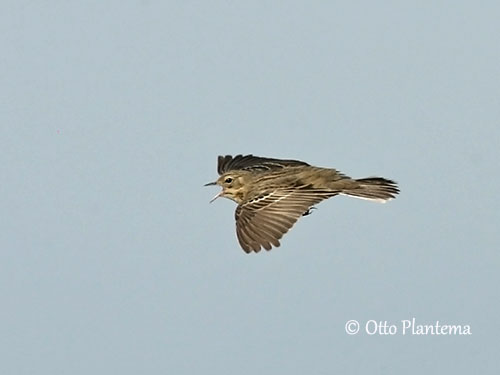
REPRODUCTION OF THIS SPECIES:
The breeding season takes place between late April and August in NW Europe. The Tree Pipit usually produces two broods, rarely three.
The female builds the nest on the ground, often in a shallow depression well hidden among the vegetation. The cup-shaped structure includes moss foundation. The cup is made with dry grass and lined with finer and softer grass.
The female lays 4-6 pale brownish eggs with darker spots, and incubates during 12-14 days. The chicks are fed by both parents with insects and caterpillars. They fledge 12-14 days after hatching, but they usually leave the nest several days earlier.
The nest can be parasitized by the Common Cuckoo.
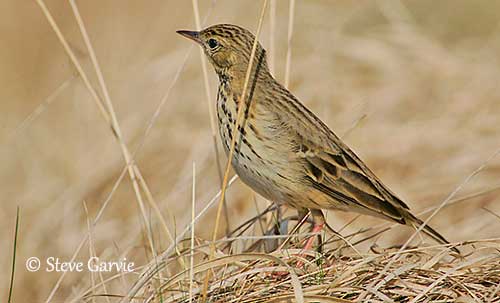
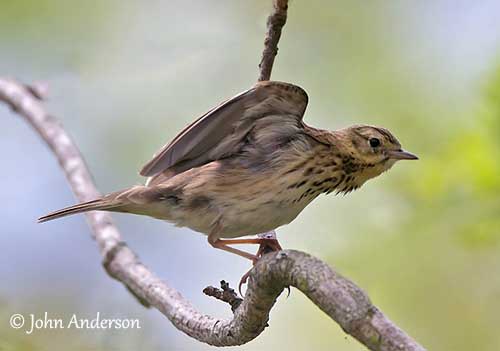
PROTECTION / THREATS / STATUS:
The Tree Pipit has wide range in which it is common. Marked declines are reported in Netherlands since 1900s, and also in England, N Finland and Switzerland. However, the species has expanded its range in Scotland during the 20th century. Fluctuations are usually due to changing nature of habitats.
The European population is estimated at 27,000,000/42,000,000 breeding pairs (81,000,000/126,000,000 individuals). As Europe forms 25/49% of the global range, a preliminary estimate of the global population size is 165,000,000/504,000,000 individuals.
The Tree Pipit is currently evaluated as Least Concern.
